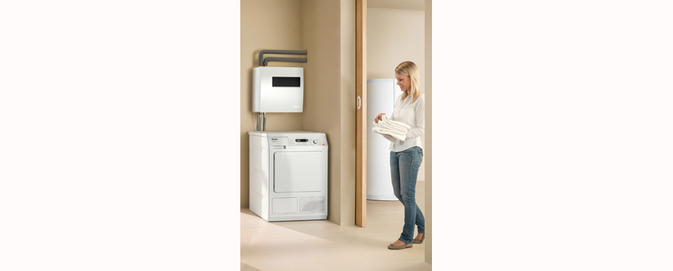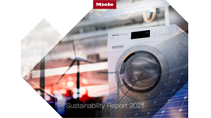Press releases
Cutting electricity costs and utilising solar-thermal panels to the full
Gütersloh/Berlin, September 4
No. 119/2013

Solar dryer from Miele uses up to 80% less electricity/ Contribution towards intelligent energy management
The T 8881 S EcoComfort is the world's only solar-powered tumble dryer. It uses the sun's energy to heat the air needed to dry laundry. The dryer is connected to a home's central heating system which, in turn, is linked to a solar-thermal rooftop array. This reduces the burden on the environment as a solar dryer with an A+++ energy efficiency rating is up to 80% more efficient than a conventional dryer.
A solar dryer makes direct use of the sun's energy without first converting it into electricity. This requires a solar-thermal array which feeds hot water into a central heating system via a stratified storage tank. The first project study on this subject was jointly presented by Miele and Solvis, the solar-thermal specialist, at IFA 2011 in Berlin. Now, on completion of final R&D specifications and after exhaustive product testing, not least to Miele's 20-year life expectancy benchmark, the appliance is now ready for series production.
As the solar dryer requires considerably less primary energy, energy costs compared with a highly efficient heat-pump dryer have been reduced by a further 60% (or by 80% compared with a vented or condenser dryer). Given normal usage by a family of four, the added costs of this machine (around € 500) are capitalised within just over 7 years. Practical: During the summer, the solar dryer helps utilise the hot water produced by a rooftop array to the full; in winter, the water in the stratified storage tank can be alternatively heated using bio-mass or geo-thermal heat.
The solar dryer is connected to the storage tank via four lines. The first transports hot water to the dryer, where heat transfer to process air takes place in a heat exchanger. In the process, the water cools down and is returned to the storage tank via a second line. A third connection pipes cooler water from the storage tank into the dryer in order to cool down the warmer air returning from the dryer. The moist air is then cooled down in a second heat exchanger to condense out moisture. This is then piped back to the tank along a fourth line. Thanks to this closed circuit, temperature losses are negligible as for the most part the heat extracted for drying laundry is re-introduced to the storage tank in the condensation process.
In terms of drying results, the solar dryer is comparable to its more conventional counterparts. The low process air temperature is similar to that on a heat-pump dryer, resulting in extremely gentle care being taken of textiles. The use of solar-heated water is also possible on other Miele domestic appliances such as dishwashers and (AllWater) washing machines.
(381 words, 2503 characters incl. spaces)
Company profile: Miele is the world leader in the field of premium domestic appliances including cooking, baking and steam-cooking appliances, refrigeration products, coffee makers, dishwashers and laundry and floorcare products. This line-up is augmented by dishwashers, washer-extractors and tumble dryers for commercial use as well as washer-disinfectors and sterilisers for use in medical and laboratory applications (Miele Professional). The company, founded in 1899, has 8 production plants in Germany and one plant each in Austria, the Czech Republic, China and Romania. 2012/13 turnover amounted to approx. EUR 3.15 bn with sales outside Germany accounting for 70%. Miele is represented with its own sales subsidiaries and via importers in almost 100 countries. The Miele company, now in the fourth generation of family ownership, employs a workforce of around 17,250 with two-thirds in Germany. The company headquarters are located in Gütersloh/Westphalia, Germany.
Download as PDF Download incl. media (zip)
Your contact
Media information
| Description | Download |
|---|---|
 A solar dryer makes direct use of the sun's energy without first converting it into electricity. This requires a solar-thermal array which feeds hot water into a central heating system via a stratified storage tank. This reduces the burden on the environment as a solar dryer with an A+++ energy efficiency rating is up to 80% more efficient than a conventional dryer.
A solar dryer makes direct use of the sun's energy without first converting it into electricity. This requires a solar-thermal array which feeds hot water into a central heating system via a stratified storage tank. This reduces the burden on the environment as a solar dryer with an A+++ energy efficiency rating is up to 80% more efficient than a conventional dryer.
|
High Resolution TIFF |
| High Resolution JPG |


